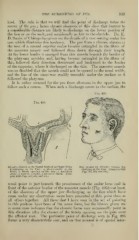Page 929 - My FlipBook
P. 929
THE BURROWING OF PUS. 939
lead. The rule is that we will find the point of discharge below the
source of the pus ; hence chronic abscesses of tliis class that burrow to
a considerable distance are likely to discharge on the lower portion of
the face or on the neck, and occasionally as low as the clavicle. Dr. E.
D. Swain of Chicago lias given me the details of a case coming under his
care which illustrates this tendency. The pus from a chronic abscess at
the root of a second superior molar became entangled in the fibres of
the masseter muscle and followed them down through their length.
At the lower border it emerged from this muscle beneath the border of
the platysma myoides, and, having become entangled in the fibres of
this, followed their direction downward and backward to the border
of the trapezius, where it discharged on the skin. The masseter muscle
was so disabled that the moiith could not be opened to the usual width,
and the line of the sinus was readily traceable under the surface as it
followed the platysma.
It is rather unusual for the pus from abscesses in the upper jaw to
follow^ such a course. When such a discharge comes to the surface, the
Fig. 496.
Fig. 495.
Alveolar Abscess at the Buccal Roots of au Upper Molar Scar caused by Alveolar Abscess dis-
discharging on the Face: a, abscess-cavity in the charging on the Face. (Compare with
bone; t), fistula opening on the face; c, maxillary Figs. 495, 504, and 490.)
sinus; rf, nostril : e, tooth f, tissues of cheek. (Com-
;
pare with Figs. 490, 496, and 504.)
usual point is just beneath the prominence of the malar bone ?,nd in
front of the anterior border of the masseter muscle (Fig. 495)—at least,
of the abscesses of the upper jaw discharging on the face which have
come under my observation more have presented at this point than at
all others together. All those that I have seen in tlie act of pointing
in this ])osition have been of the acute form, but the history given me
in some cases indicates that the chronic forms may occasionally point in
this direction after the closure of the fistula opening on the gum over
the affected root. The particular point of discharge seen in Fig. 496
forms a very characteristic scar, and on that account is of special inter-


